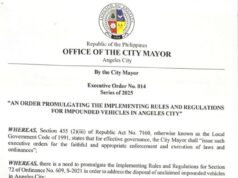CLARK FREEPORT – Just a few days after Pres. Aquino admitted that plans for the Clark International Airport (CIA) have been stalled, the airport here again hosted yesterday unexpected flight diversions from the Ninoy Aquino International Airport (NAIA) where the instrument landing system (ILS) reportedly bogged down.
The Air Transportation Office (ATO) said that it received notice of the flight diversion from NAIA at about 10 a.m. and that by noon, about 14 flights bound for Manila had instead landed here.
The ILS is a ground-based instrument that guides aircraft landing on an airport with the use of radio signals and, in some cases, high-intensity lighting arrays to enable safe landing during bad weather.
An ATO personnel who asked not to be named for lack of authorization said that the diverted flights yesterday consisted of both international and domestic airlines.
Some of the airlines visible from the airport tower included Thai Airways, Philippine Airlines, AirAsia, Cebu Pacific and Asiana, he added.
No official from the Clark International Airport Corp. (CIAC) could immediately be reached for interview.
Only last Friday in the City of San Fernando, Pampanga, Pres. Aquino admitted that plans for a world-class passenger terminal at the CIA remained stalled by the lack of efficient railway system between Clark and Metro Manila.
In a press conference, he noted that Clark is over 80 kilometers from Metro Manila, while the accepted standard is 40 kilometers between an international airport and the capital.
The President also said that the government has yet to find a new partner to finance and construct a new railway system, as he noted that the already finished structures for the project financed by China and undertaken by the Arroyo administration were not feasible, as they were reportedly meant for only for a one-track railway.
He also justified putting the CIAC under the jurisdiction of the Department of Transportation and Communications (DOTC) despite complaints that this merely aggravated red tape in the transactions for the airport development.
He said putting the CIAC under DOTC was needed so as to “coordinate” all projects needed for the airport, including the north railways.
The CIA, which was declared by former Pres. Ramos in 2004 as the “future site of the country’s premiere international airport,” has two runways each running 3.5 kilometers and is capable of accommodating modern wide-bodied aircraft.
In recent years, the CIA had frequently served as alternative airport to NAIA during emergencies, such as last Jan. 1 when flights were diverted to it due to smog that caused zero visibility at the NAIA.
Last July, the airport here again accommodated foreign and domestic aircraft diverted from Manila arising from bad weather. This again happened last August.
Also only recently, flights had to be diverted to Clark because of air traffic congestion at NAIA.
In one interview, CIAC president Victor Jose Luciano noted that local airport operations always remained normal here despite bad weather.
At one time when flights were diverted here, some 262 passengers of an Airbus 330 Hong Kong Express even were accommodated at Fontana Leisure Park here as authorities waited for the weather to clear.



